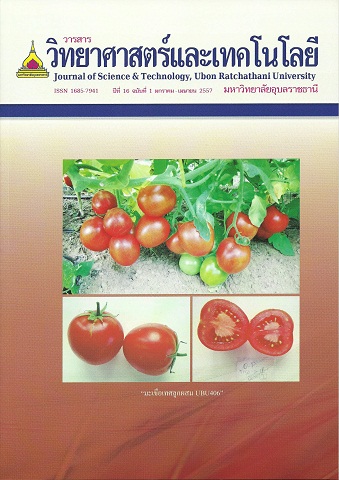ผลของโคลชิซินต่อการชักนำให้เกิดโพลีพลอยด์ในกล้วยไม้เหลืองจันทบูรดาเต็มคอ (Dendrobium friedericksianum Rchb.f var. oculatum)
Main Article Content
บทคัดย่อ
จากการศึกษาผลของความเข้มข้นและระยะเวลาการให้โคลชิซินต่อการชักนำให้เกิดโพลีพลอยด์ในกล้วยไม้เหลืองจันทบูรดาเต็มคอ โดยนำโปรโตคอร์มกล้วยไม้เหลืองจันทบูรอายุ 1 เดือนหลังจากงอกแช่อาหารเหลวสูตร Vacin & Went (VW) ที่ผสมโคลชิซินความเข้มข้น 0.00%, 0.10%, 0.15% และ0.20% เป็นระยะเวลา 1, 2, 3, 4, 5, 6 และ 7 วัน จากนั้นย้ายโปรโตคอร์มมาเลี้ยงในอาหารแข็งสูตร VW เป็นระยะเวลา 3 เดือน พบว่า อัตราการรอดของโปรโตคอร์มในแต่ละทรีตเมนต์มีความแตกต่างกันอย่างมีนัยสำคัญทางสถิติ (p<0.05) โดยอัตราการรอดลดลงตามความเข้มข้นและระยะเวลาที่แช่โคลชิซิน ความเข้มข้นและระยะเวลาที่แช่โคลชิซินทำให้ได้อัตรารอดสูงสุด (96.33%) คือความเข้มข้น 0.10% แช่เป็นระยะเวลา 1 วัน จากนั้นนำต้นอ่อนกล้วยไม้เหลืองจันทบูรดาเต็มคอมาเลี้ยงจนอายุครบ 9 เดือน แล้วนำมาวัดระดับพลอยดีด้วยวิธี Flow cytometric พบว่า การเกิดโพลีพลอยด์ของกล้วยไม้กลุ่มควบคุมที่ไม่ผ่านการแช่โคลชิซินมีระดับพลอยด์ดีเป็น 2n=2x (ดิพลอยด์) และกลุ่มทดลองที่ผ่านการแช่โคลชิซินมีระดับพลอยด์ดีเป็น 2n=4x (เตตระพลอยด์) ความเข้มข้นและระยะเวลาในการแช่โคลชิซินที่มีประสิทธิภาพมากที่สุดคือ โคลชิซินความเข้มข้น 0.10% แช่ระยะเวลา 3 วัน ซึ่งมีอัตราการรอดของโปรโตคอร์มกล้วยไม้ คือ 94.33% และ มีระดับพลอยดีเป็นเตตระพลอยด์ 100 % เมื่อเปรียบเทียบลักษณะต้นที่เกิดเตรตระพลอยด์และต้นดิพลอยด์ พบว่ามีความแตกต่างกันอย่างชัดเจนโดยต้นที่เกิดเตตระพลอยด์มีลำต้นสั้นหนา ใบและรากสั้นกว่าต้นดิพลอยด์ เมื่อนับจำนวนและวัดขนาดของปากใบพบว่าต้นที่เกิดเตตระพลอยด์จำนวนปากใบน้อยและความยาวเฉลี่ยของปากใบสั้นกว่าต้นดิพลอยด์
Effects of Colchicine in the Induction of Polyploidy of Dendrobium friedericksianum Rchb.f. (var. oculatum)
The effects of colchicine concentrations and immersion time for inducing polyploidy of Dendrobium friedericksianum Rchb.f. (var. oculatum) was carried out by soaking the 1 month protocorms in a mixture of Vacin&Went (VW) and colchicines with the concentrations of 0.00%, 0.10%, 0.15%, and 0.20% for 1, 2, 3, 4, 5, 6 and 7 days respectively. The protocorms were then transferred to solid VW medium for 3 months. It was found that the protocorms survival rates were reduced significantly at the level of 0.05 when treated with high concentrations and long periods of immersion time in the colchicines. The highest survival rate of protocorms was 96.33% to be found at a colchicine concentration level of 0.10% and immersion time of 1 day. After that the plantlets were cultured continually on solid VW medium until 9 months of age. Then the ploidy levels of the 9 month plantlets were measured by the flow cytometric method. It was found that the ploidy level of 2n=4x occurred in the plantlets which were treated by colchicine while the ploidy level of 2n=2x occurred in the plantlets of the control group. The most effective method of treatment was 0.10% colchicine for 3 days which resulted in about 94.33% survival PLBs (protocorm like bodies) and with 100% of tetraploid orchids. The characteristics of the tetraploid plantlets were distinctly different from the diploid plantlets in that they had thicker and shorter stems, shorter leaves and roots, and less than average numbers of stomata and average lengths of guard cells.
Article Details
บทความที่ได้รับการตีพิมพ์เป็นลิขสิทธิ์ของ วารสารวิทยาศาสตร์และเทคโนโลยี มหาวิทยาลัยอุบลราชธานี
ข้อความที่ปรากฏในบทความแต่ละเรื่องในวารสารวิชาการเล่มนี้เป็นความคิดเห็นส่วนตัวของผู้เขียนแต่ละท่านไม่เกี่ยวข้องกับมหาวิทยาลัยอุบลราชธานี และคณาจารย์ท่านอื่นๆในมหาวิทยาลัยฯ แต่อย่างใด ความรับผิดชอบองค์ประกอบทั้งหมดของบทความแต่ละเรื่องเป็นของผู้เขียนแต่ละท่าน หากมีความผิดพลาดใดๆ ผู้เขียนแต่ละท่านจะรับผิดชอบบทความของตนเองแต่ผู้เดียว


